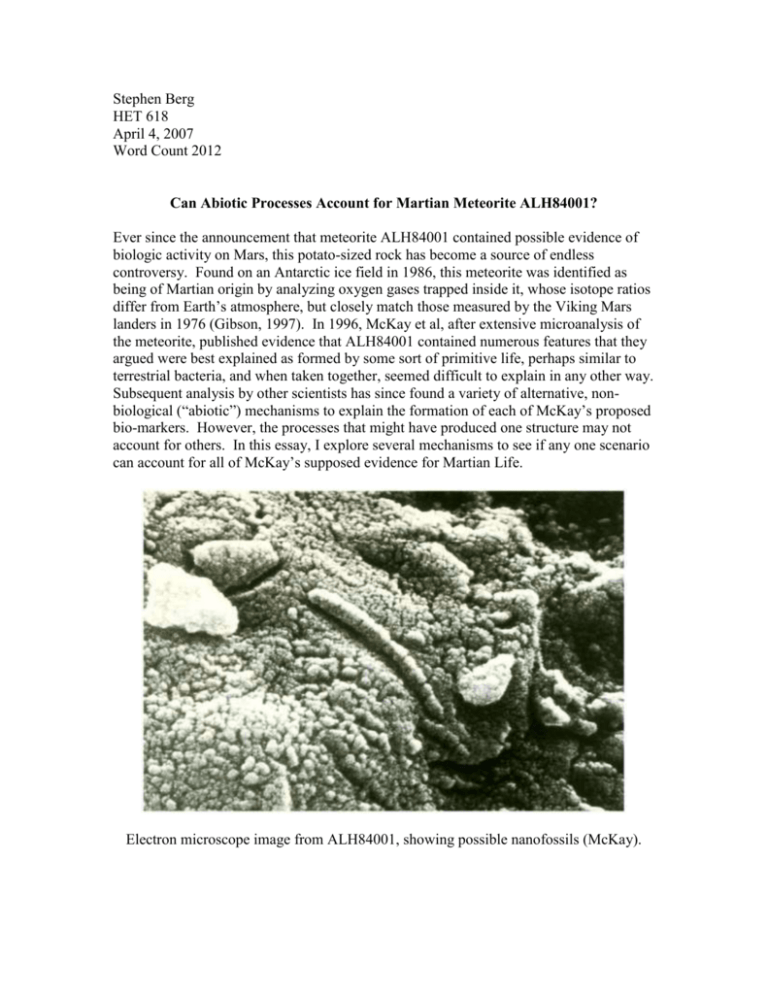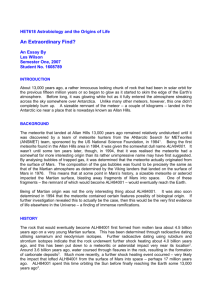Essay-HET618
advertisement

Stephen Berg HET 618 April 4, 2007 Word Count 2012 Can Abiotic Processes Account for Martian Meteorite ALH84001? Ever since the announcement that meteorite ALH84001 contained possible evidence of biologic activity on Mars, this potato-sized rock has become a source of endless controversy. Found on an Antarctic ice field in 1986, this meteorite was identified as being of Martian origin by analyzing oxygen gases trapped inside it, whose isotope ratios differ from Earth’s atmosphere, but closely match those measured by the Viking Mars landers in 1976 (Gibson, 1997). In 1996, McKay et al, after extensive microanalysis of the meteorite, published evidence that ALH84001 contained numerous features that they argued were best explained as formed by some sort of primitive life, perhaps similar to terrestrial bacteria, and when taken together, seemed difficult to explain in any other way. Subsequent analysis by other scientists has since found a variety of alternative, nonbiological (“abiotic”) mechanisms to explain the formation of each of McKay’s proposed bio-markers. However, the processes that might have produced one structure may not account for others. In this essay, I explore several mechanisms to see if any one scenario can account for all of McKay’s supposed evidence for Martian Life. Electron microscope image from ALH84001, showing possible nanofossils (McKay). Background ALH84001 is formed primarily of igneous orthopyroxenite (opx), (Mg,Fe)SiO3, mixed with diverse mineral impurities, with those containing Mg, Fe and Ca being the most significant. Analysis of various radioactive isotopes has shown that the rock first crystallized about 4.5 billion years ago (Ga), followed by a shock event (presumably an impact) at 4.0 Ga. Carbonate globule formation was estimated at 3.6 Ga (McKay, 1996), although more recent studies place this near to or contemporaneous with the shock event (Gibson, 2001, Barber, 2003). About 16 million years ago, the rock was ejected into space, probably by another impact, and then landed in Antarctica about 13,000 years ago (Gibson, 1997). These events are generally agreed upon, although additional shocks have been hypothesized in some scenarios,. With mounting evidence that Mars early history included extensive water with a more substantial atmosphere and warmer climate, the question naturally arises whether life formed under these conditions, and if so, might ALH84001 harbor evidence of this life? McKay (1996) hoped to find such indicators, and found four distinct lines of evidence that in combination they felt strongly suggested microbe-like life. Briefly they are as follows: 1. Water appears to have been present in the rock, contributing to the formations found inside, and being available for possible biological activity. 2. Tiny carbonate globule formations contain a number of features resembling evidence of terrestrial biological activities. Among them are ovoid shapes that appear to resemble certain terrestrial microfossils. 3. Crystals of magnetite were observed to resemble chains of magnetite formed by certain Earth bacteria, ostensibly for the purpose of aiding navigation within the Earth’s magnetic field. These are also found in close proximity to iron sulfide particles, a not uncommon biological association, but difficult to explain abiotically. 4. Complex hydrocarbons called PAH’s (polycyclic aromatic hydrocarbons) are found in profusion deep within the meteorite. While these are also found in nonMars meteorites, the types found are suggestive of the decay of biological material. Critical response was immediate, with questions raised at almost every point. Early criticism centered on possible contamination as the source of the PAH’s, while the size of the ovoids appeared to be too small for viable living organisms. The contamination issue seems to have been put to rest by studies showing that the indigenous Antarctic PAHs not only have far lower concentrations than those in the meteorite (McKay), but are not even of the same chemical type (Gibson, 2001). Other researchers have considered the PAH origin too uncertain to be meaningful, since they could have been produced either with or without biological activity (Treiman, 2000). The ovoids, with dimensions ranging from 20 to 100 nm in size, bear resemblance to certain terrestrial features thought to be fossilized nanobacteria (McKay). However, they are considerably smaller than terrestrial bacteria, and may be too small to contain sufficient chemistry to make life possible (Gibson, 2001). Although this does not preclude a biological origin, neither does it present a compelling case in its favor (Treiman, 2000). At present, the ovoids seem also to have lapsed into ambiguity. Magnetites More recent debate has focused on the carbonate globules and the associated magnetite and sulfide crystals. The globules are profuse, and are found mainly along cracks and fractures in the rock, where they could have formed either by precipitating from water, or from biogenic activity. Some are spherical, while most are flattened, probably due to the restricted space within the fractures. The largest are 10 or more microns in diameter, and several have been examined carefully with electron microscopes. McKay (1996) found significance in the structure of the globules they studied, especially the presence of thin, concentric bands having contrasting mineral contents, whose presence near each other is difficult to explain. The cores contain alternating Fe and Mg-rich bands, while the outer edges show three concentric bands, with the first and third rich in Fe and S, while the intermediate band lacks Fe, containing Mg instead. Magnetite crystals (Fe3O4) were found throughout the globules, with high concentrations near the rim (Thomas-Keprta, 2005). McKay (1996) suggested that the carbonates, magnetites and sulfur compounds could all have precipitated inorganically under conditions of moderate temperature and high pH. However, porous structuring in the carbonates show evidence of later acidic conditions, which are not mirrored in either the magnetites or pyrrhites. Since these can both be produced by Earth bacteria, McKay found their juxtaposition to be more plausibly explained by biotic precipitation. The magnetites vary considerably in size and shape, with about 25% displaying a crystalline structure remarkably similar to those produced by terrestrial bacteria. These crystals are very pure, and are not known to occur abiotically in nature (Thomas-Keprta, 2001). Some of these also form chains similar to those produced by bacteria (Gibson, 1997), while magnetite clustering suggests formation by colonies of microbial life (Gibson, 2001). An extensive study by Barber (2003) found the magnetites to be closely associated with the numerous voids near the carbonate rim. They argue that biologically produced chains would not have been maintained once the organisms died, and that chains form easily and more permanently along ledges on fracture surfaces. They found atoms from the carbonates had diffused over short distances, indicating that heating to at least 400º C must have occurred, and conclude that cool formation of the magnetites was not possible (Barber). Their proposed scenario has the magnetites and pyrrhites forming inside the carbonates by exsolution from the existing solid mixture as a result of the shock at 4.0 Ga, with neither melting nor dehydration being required. Because the magnetites formed inside the carbonates, no life could have been involved (Barber). Golden et al in 2003, and again in 2004 were able to produce magnetites synthetically that they describe as “indistinguishable” from the ALH84001 magnetites. Both processes required heating (550º C and 350º C) in a CO2 environment, simulating early Mars. Although significant, the processes required both gradual heating and cooling, neither of which resembles the shock approach proposed by Barber, or other realistic scenarios. Thomas-Keprta (2005) concludes that the way the magnetites are embedded in the opx precludes formation by a simple precipitation method, but also finds that thermal decomposition alone cannot explain their origin. While the Barber study casts considerable doubt on the value of the magnetites as biological markers, it is unclear if either Barber or Golden produce a viable alternative. The ambiguity is perhaps best stated by Trieman (2000), who questioned why bacteria living inside a rock would even need magnetites! Sulfides The Fe sulfide crystals McKay found in close proximity to magnetites require that the Fe have been both reduced and oxidized in nearly the same location. The McKay team found this difficult to understand unless bacteria-like organisms were present. However, this argument ignores that the sulfides were found in two sizes, only the smaller of which was proposed by McKay as being biogenic (Gibson, 2001). Conversely, Barber (2003) does not see a problem with the two crystals forming side by side if the sulfides formed as a result of shock heating. Golden (2004) was able to precipitate both sulfides and magnetite, as well as carbonate globules, from solution after heating gradually to 550º C in a CO2 atmosphere, followed by rapid cooling. Other experiments also produced carbonate globules as well, although fracturing patterns indicate that the carbonates had to have formed prior to the magnetites (Trieman, 2002). I join Gibson (2001) in finding the sulfide evidence inconclusive. Carbonate Globules Carbonate globules from ALH84001. Globules are crushed inside feldspathic glass and opx (Treiman, 2005). Sections of the concentric rings are clearly visible. The carbonate globules, tiny disks ranging from 20 to 250 microns in diameter, are found covering the walls of fractures inside the meteorite. Gibson (1997) found that they appeared to have precipitated out of a fluid saturated with CO2. Thomas-Keprta (2005) noted their well-formed internal structure of chemically differentiated rings, radiating concentrically outward from the center, similar to the structure reported by McKay. Controversy was already reported by McKay in their original paper with two quite different temperatures of formation indicated. Electron microprobe suggested the carbonates formed at about 700º C, while oxygen isotope data indicated a temperature between 0 and 80º C. Biogenic activity would presumably require the much cooler temperature range, and McKay notes similarly structured formations are found precipitated by Earth bacteria in fresh water. Arguments have also been made for other temperatures. Kirschvink (1997) used magnetic orientation to derive a temperature of about 150º C. Others have argued for temperatures near 200º C, or above 650º C (Barber). Barber concludes the globules formed as a result of sudden and transient heat generated by an impact event, while Treiman (2005) believes them to be better explained as deposits from an aqueous solution into cavities within the rock. Barber believes subsequent shocks were of much lower intensity, producing temperatures of less than 400º C, but assumes the magnetites formed with the carbonates. Gibson (2001) argues against high temperature shock formation, stating that CaO and MgO should also have formed, and they are absent. Clearly no conclusions can be reached until the formation temperature is more precisely known. Conclusion With the obvious confusion concerning ALH84001, it is difficult to know if a single abiotic scenario can account for all of this meteorites supposed biological markers. Golden has duplicated the most difficult features of magnetites, sulfides and carbonates, but at the expense of conditions that do not match the sudden heating of an impact. Barber offers the most comprehensive analysis, but requires the magnetites to form with the carbonates in a single shock, despite fracturing evidence that the magnetites were formed later (Treiman, 2002). Treiman (2005) offers a quite different scenario based on similar terrestrial rocks found in Norway. Early fracturing opened these rocks to water, which dissolved exposed olivine crystals, and replaced them with carbonates. Small olivines were less likely to be exposed by the fractures and have survived, while later shocks filled in the remaining voids. This low temperature version requires no biological assistance, although it is not clear if it can account for the magnetites and sulfides. Extensive studies of ALH84001 by numerous scientists have cast strong doubt on the origin of McKay’s proposed biogenic markers. While it now seems likely that most or all of these features are not biological in origin, we are still awaiting a satisfactory scenario capable of explaining them all. We must also be more certain of the temperatures involved, and whether or not water played a part. Until these issues are resolved, ALH84001 will continue to tease us with the possibility that it gives testimony to early Martian life. Despite unprecedented analysis, this small meteorite has kept its secrets well. Like Mona Lisa’s smile, we wonder what da Vinci is hiding from us. Is there a tale of Martian life? Or is there no secret at all? We do not yet know the answer. References: Barber, D. & Scott, R., 2003, Transmission electron microscopy of minerals in the martian meteorite Allan Hills 84001, Meteoritics & Planetary Science 38, pp. 831, 841-3, 845, 841-3, 845, 832-3, 846, 844. Gibson, E., et al, 1997, The Case For Relic Life On Mars, Scientific American, vol. 277, pp. 2-3, 4, 6, 4. Gibson, E., et al, 2001, Life on Mars: evaluation of the evidence within Martian meteorites ALH84001, Nakhla, and Shergotty, Precambrian Research 106, pp. 17, 19, 22, 28, 28 & 19, 19, 18. Golden, C., et al, 2003, Morphological Evidence for an exclusively Inorganic Origin for Magnetite in Martian Meteorite ALH84001, Lunar and Planetary Science XXXIV. Golden, C., et al, 2004, Thermal Decomposition of Siderite-Pyrite Assemblages: Implications for Sulfide Mineralogy in Martian Meteorite ALH84001 Carbonate Globules, Lunar and Planetary Science XXXV (2004). Kirschvink, J., Maine, A. & Vali, H., 1997, Paleomagnetic Evidence supports A LowTemperature Origin of the Carbonate in Martian meteorite ALH84001, Lunar and Planetary Science XXVIII. McKay, D., et al, 1996, Search for Past Life on Mars: Possible relic Biogenic activity in Martian Meteorite ALH84001, Science, pp. 924, 929, 925, 928, 926, 927-8, 924, 929. Thomas-Keprta, K., et al, 2001, Truncated hexa-octahedral magnetite crystals in ALH 84001: Presumptive biosignatures, PNAS, pp. 2164-8. Thomas-Keprta, K., et al, 2005, Focused Ion Beam Microscopy of ALH84001 Carbonate Disks, Lunar and Planetary Science XXXVI (2005). Treiman, A., 2000, A Short, Critical evaluation of Proposed Signs of ancient Martian Life in Antarctic Meteorite ALH 84001, ASP Conference Series, Vol. 213, pp. 305, 311, 307. Treiman, A., 2002, The Timing of Magnetite Formation in ALH84001 Carbonate Globules, 65th Annual Meteoritical Society Meeting (2002) Treiman, A., 2005, Olivine and Carbonate Globules in ALH84001: A Terrestrial Analog, and Implications for Water on Mars, Lunar and Planetary Science XXXVI (2005). Acknowledgements The NASA ADS retrieval system was used to locate and retrieve publications for use in this paper.






